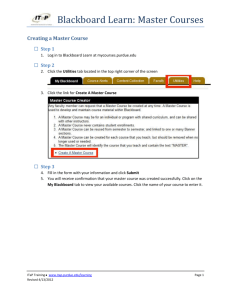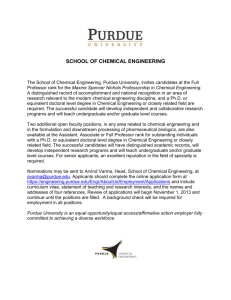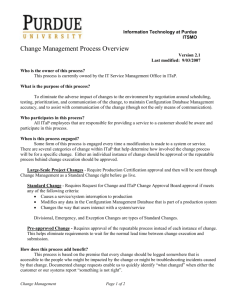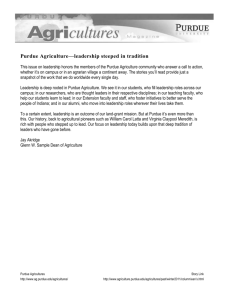Information Technology at Purdue Supporting Purdue's Strategic
advertisement
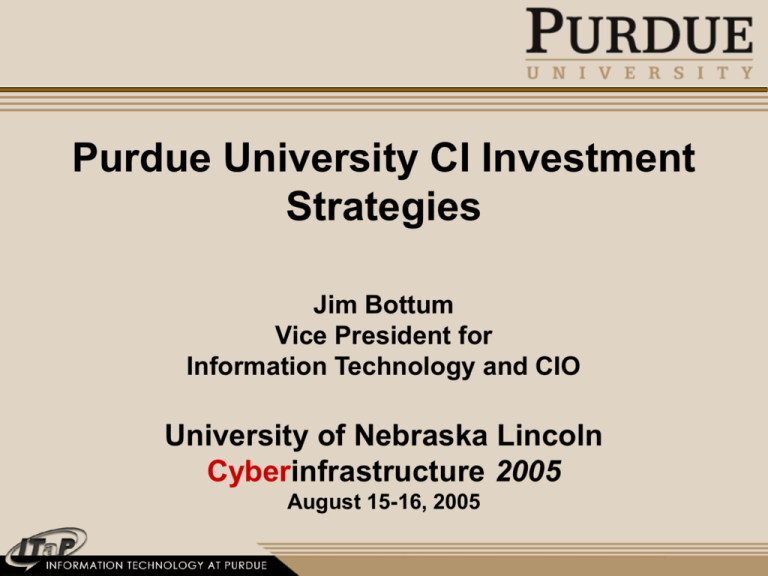
Purdue University CI Investment Strategies Jim Bottum Vice President for Information Technology and CIO University of Nebraska Lincoln Cyberinfrastructure 2005 August 15-16, 2005 Outline Purdue in Transition Strategic Plan and Vision IT Strategy Resources Partnerships 2 Purdue in 2000 High degree of local autonomy Numerous IT organizations including multiple “central” organizations Trustees recruited new President with a mandate to develop a strategic plan for preeminence President brought in a new team including Purdue’s first CIO – non-traditional candidate CIO position based on a plan developed by the University community 3 Purdue Strategic Plan Strategy • Enhance library and other information resources, and provide state-of-the-art computational and information technology resources supporting campus wide research, learning environments, and the business enterprise Metrics • Library acquisitions • Electronic library and other information access services and usage • Computational and information technology improvements and expenditures, and annual assessment of needs met Source: Purdue University Strategic Plan 4 Funding the Plan Strategy • • Purdue's vision … will require a carefully constructed funding scheme to support and implement the strategic plan. The University strategic plan, along with the strategic plans of the schools and other major units, will establish the framework for setting annual priorities and guiding the major budgetary decisions. Interdependence of various funding sources and the importance of a partnership of these funds in supporting key initiatives • • • • • • • State Appropriations Federal Appropriations Fees and Tuition Sponsored Funding Internal Reallocation Private Giving Revenues from Licenses and Patents Key Investment Areas • Strengthening the infrastructure including facilities and information technology Source: Purdue University Strategic Plan 5 Translating the IT Vision Into Action Develop IT strategic plan in collaboration with both central and distributed IT staff Consolidate and integrate central IT activities creating ITaP Update, upgrade and in some cases reengineer the infrastructure (lifecycle replacement strategies) Build alliances with faculty and distributed IT support staff Began to think as an enterprise! 6 IT Strategic Plan The Information Technology Strategic Planning Task Force was charged with developing a vision and implementation plan for creating a world-class digital information infrastructure and building services that support all of Purdue’s strategic efforts. Strategic principles drove the development of the plan: • Collaboration is essential for this plan to succeed. • Applications drive the need for technology and technology should never be thought of as an end in itself. • An enterprise approach assures leverage. • Users must have ubiquitous access to resources. 7 IT Planning Process – Strategy to Implementation Purdue Strategic Plan Current IT Environment IT Strategic Plan 2002 2003 2004 2005 2006 2007 4 High Nodes (16 CPU, 64 GB) IBM SP 64 Thin Nodes Future SP Upgrade / Replacement 1 Regatta (32 CPU, 64 GB) Clusters 250 PIII/550 MHZ 500 PIV/1.6 GHZ PC Recycled Clusters 250 PII/450M 500 PIII/933 MHZ 500 PIV/1.8 GHZ IA - 64 New Clusters Second IA - 64 Sun Recycled Clusters 50 Sparc Ultra 5 450 MHZ 50 Blade 100 500 MHZ Distributed 600 PIV / 1.6 GHZ PC Distributed 600 PIV / 1.8 GHZ 550 PIII/933 MH Sun/Solaris Distributed 90 Sparc Ultra 5 450 MHZ 600 PIV 2.2 GHz 90 Sparc Blade 100 500 MHZ Legend: Commitment Level Committed Limited Commitment Uncommited (but in LRP) Road Maps 8 Resources FY04-05 ITaP Budget Administration, 7% Customer Support,9% Learning, 25% Cross-Cutting Infrastructure, 31% General Fund Budget Auxiliaries NR Technology Reserve Grants (0% - 2001) 68% 24% 3% 5% Enterprise Applications,19% Discovery, 9% (5% in 2002) 9 Resource Initiatives “cheap cycles” High Throughput Computing Capturing unused cycles, 2,800 desktops Community Cluster Massively parallel & large memory IBM SP3 Sun F6800 Servers 10 HPC Community Cluster Schools/Departments/Faculty buy into a the cluster by purchasing individual identical compute nodes • current participation: Science; Engineering; Agriculture; Bio; ME; ECE; EAS; Mgmnt; Physics ITaP aggregates all nodes together and operates as a single cluster • in practice this has become multiple clusters and we have gone from 1 to 15 teraflops on the floor in a little over a year Through scheduling (Maui) ITaP guarantees that a contributor can receive on demand the number of nodes that were contributed Priority access to additional nodes is given to contributors to the community cluster • Benefits: • • • • three layer strategy using Condor Leveraging a larger resource with their investment No burden of administration, i.e. purchasing and managing Professionally managed off site Housed in centralized facilities freeing departments from converting academic space to machine rooms MOU’s and SLA’s are established to cover a three year commitment 11 Resource Initiatives Purdue Terrestrial Observatory Envision Center Faculty driven initiative Managed & supported by ITaP Funded by Purdue (operations); NSF grant, (equipment); vendors (IBM, Intel) Over 50 projects & center written into 34 proposals Real-time earth observing multiple satellite receiving station Support - seed money, integration with VPR led environmental initiative and project oversight by CIO office Add’l funding: 3 WL colleges, IUPUI Initial effort - 35 faculty/20 academic departments Capability - Multiple data-stream sources 3 grants funded; 5 pending; 6 in development 12 Discovery – Visualization T4 bacteriophage infecting an Escherichia coli cell – Led by: Michael G. Rossmann Vadim V. Mesyanzhinov Fumio Arisaka Venigalla B. Rao 13 Learning Resources Replacing WebCT Campus Edition Fall 2004 • • • • • • • Encompass libraries system integration Business Process Redesign for SIS Integration with media and content development tools (Macromedia Breeze, etc) Scantron grade integration (> 1 M grades loaded) Implementation of foreign language components Security assessment Archival and monitoring Spring, 2005 • • • • • Continue statewide phased Vista deployment integration with e-instruction e-portfolios analysis integration with Turn-It-In (plagiarism checker) online “end of semester” course evaluations August, 2005 – Retire Campus Edition Research Delivery Vehicle – see NCN • Campus Edition 1,400 courses and 26,000 students • Vista – 1,290 courses and 27,000 students (system-wide) 14 Learning Resources mLearning - Learning – any time, any where eInstruction - Building interactions and feedback within large courses Student Response Pad Receiver Personal Computer Active Notes connecting student notes with the instructor’s presentation 15 Learning Resources To find an open seat visit: http://www.itap.purdue.edu/tlt/ • On August 16 at 1:45 PM the STEW 102 lab showed the following Status The lab is OPEN. There are 59 computers in use. There are 67 total computers. Virtual Lab - remote server-based educational applications • 86,461 connections/semester High Performance Classroom • 278 student labs • 5,424 machines • Many open 19 hrs/day; some 24/7 • 158,530 pages/day printed 16 Networking Initiatives Campus Gbit + to all buildings All new fiber (SMF) Full campus wireless deployment ($1.3 M) + 54 Mbps “Shadow network” (dark fiber) provides experimental environment To CIC Fiber Ring State National I-Light - $5M (2 Gbps) Purdue – IU TeraGrid (pictured) I-Light2 $10M in progress Also participate in: CIC Chicago Fiber Ring • • Internet2 NLR via CIC Pending Northwest Indiana Grid proposal I-Light 2 • Partners Notre Dame and Purdue Calumet 17 External Recognition 18 ITaP Organizational Information Technology at Purdue Office of the VP for IT Security & Privacy Deputy CIO Jim Bottum Greg Hedrick, interim Brett Coryell Business Areas Aligned With IT Strategic Plan Teaching & Learning Discovery Resources Infrastructure Enterprise Applications Customer Relations John Campbell Gary Bertoline Tilt Thompkins Jeff Whitten Julie Kercher-Updike Learning Spaces Envision Center for Perceptualization Operations Project & Process Management Customer Education Enterprise learning Technologies Instructional Development Center Project Process Quality Management Networks Collaborative Research & Engagement Resource Planning & Scheduling Customer Service Center Telecommunications Organizational Effectiveness Web Administration Application Services Departmental Support Desktop Computing Support Systems Purdue Terrestrial Observatory Rosen Center for Advanced Computing 19 Criteria for IT-Faculty Partnerships Project has to be part of University’s strategic direction • Work out priotities with the VPR Extra points for interdisciplinary projects • Consistent with Purdue strategic directions Funding potential • Two approaches to proposals Both sides have something to gain (in each other’s critical path) • In addition to monetary Project should be innovative Write it down (project management) Resources (have done loss leaders but…) • Loss leaders early to establish credibility 20 Building Partnerships – One Metric of Success Contracts and Grants Awarded* $12,000,000 $10,748,181 $10,000,000 $7,176,556 $8,000,000 $6,000,000 $4,000,000 $2,000,000 $862,01 1 $1,320,000 $0 2001-02 ITaP Portion 2002-03 2003-04 2004-05 YT D School/Dept Portion *Includes total amount of grants that have an ITaP PI/Co-PI. 21 Partnership Example: Nanotechnology NSF funded Purdue to lead the Network for Computational Nanotechnology (NCN); $10.5M/5 year; added $1.5M/year since inception. NCN is about computing: new algorithms, approaches, and software tools with capabilities not yet available commercially. Research integrated nanosystems NanoHUB (science gateway): on-line resources via web-based clearing-house that makes software and simulations available to researchers. devices chemistry/ materials Partners: Purdue, UTEP; UF; UIUC; Stanford; Northwestern Origins: PUNCH developed by research group, but ITaP has taken over the operation and support of this resource Serves nanotechnology researchers at Purdue and several thousand others worldwide. Jointly appointed staff & faculty members Leveraged into a grid service for heterogeneous computing under a National Middleware Initiative deployment grant. atoms Education “We could not do this without ITaP” Mark Lundstrom, Scifres distingushed professor in ECE, at the NSF site review 22 nanoHUB Architecture Propphet – device simulator RAPTURE - GUI Physical Machine Virtual Machine High throughput Grid Computing Web Presence PUNCH in-VIGO Application Middleware Resource Mgmt Cluster High-end Computing Grid 23 Online simulations and MORE collaboration animations learning modules nanoHUB.org seminars courses, tutorials online simulations 24 Leveraging Educational Standards National Learning Module Database - MERLOT online simulations and more Molecular Conduction Learning Module Q uickTim e™ and a decom pr essor ar e needed t o see t his pict ur e. I ntr oductor y L ect ure in Breeze Network for Computational Nanotechnology nano HUB.org online simulations and more Q uickTim e™ and a decom pr essor ar e needed t o see t his pict ur e. Con cr et eExam p le Pr o blem s XML-based Standard Compliant Content Description in a ZIP file Molecular Conduction Learning Module Network for Computational Nanotechnology nano HUB.org online simulations and more Molecular Conduction Learning Module An Interactive Simulation Tool in progress Course Management Systems Thousands Of Users At Many Many Universities Users nanoHUB nano HUB.org Network for Computational Nanotechnology 25 Leverage and Focus Bridge the gaps from top to bottom ! NSF-funded effort to build computational tools for a scientific community… Purdue developed - provides a “Gateway” to distribute scientific knowledge and applications Using middleware that makes the user experience seamless and rich (Recent $3M award to Purdue with UWisconsin and UFlorida as subs) And ties to a new infrastructure that goes beyond traditional HPC 26 Other Partnerships Physics - new faculty recruitment > Tier 2 Center CERIAS – security Purdue Terrestrial Observatory Climate Change Center Bioinformatics Community (condominium) Clusters from 1 – 15 teraflops in 18 months 27 Purdue Cyber Center Planning Faculty Task Force commissioned Summer 2003 Report delivered Spring 2004 Proposal to administration to become Discovery Park Center funded July 2005 (Lilly Endowment) 28 Having Fun: e-Stadium Part of “living laboratory” concept Partnership • Intercollegiate Athletics • Center for Wireless Systems & Applications • ITaP Corporate Sponsorship • $600,000 from Cisco Systems (total gift = $1.2 M) • $200,000 from Verizon Programmatic • Infotainment • Safety & Security Technology • Mobile Devices » PDA (802.11x) » Smart Phone (Cellular) Action-Packed Ross-Ade Stadium 29
